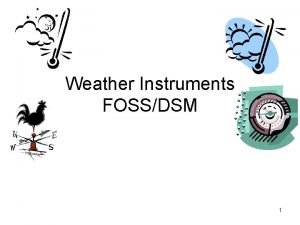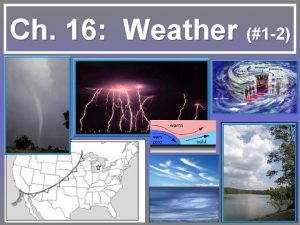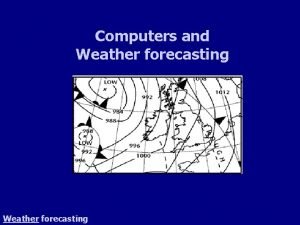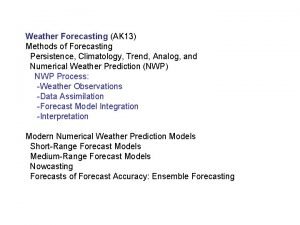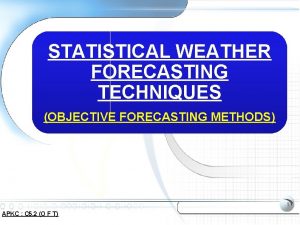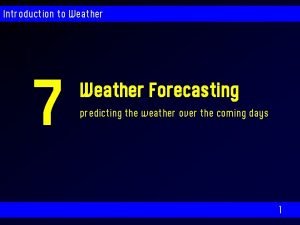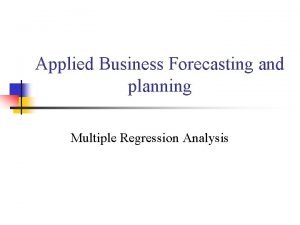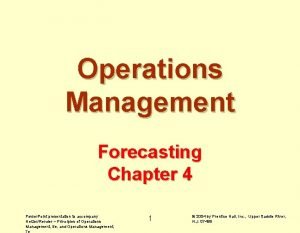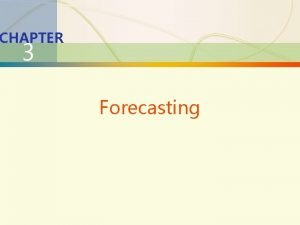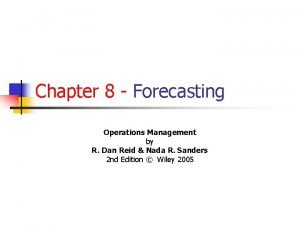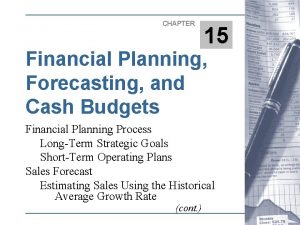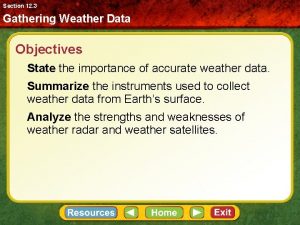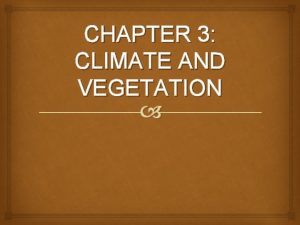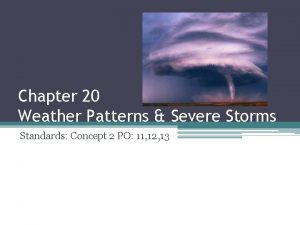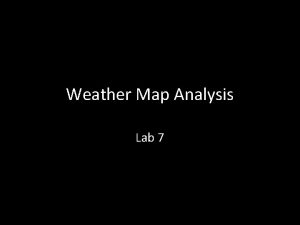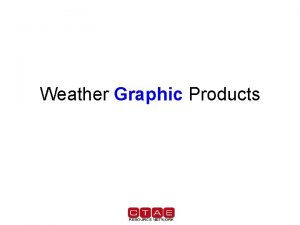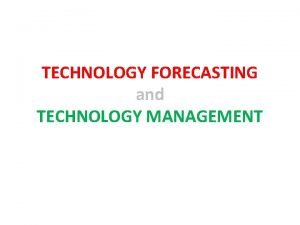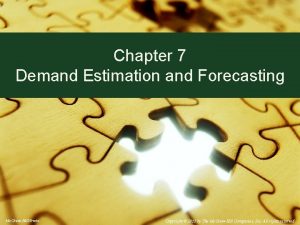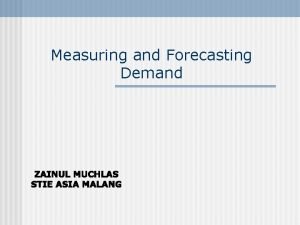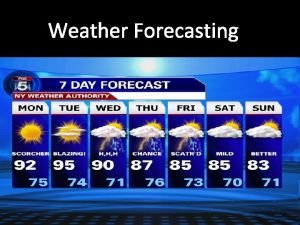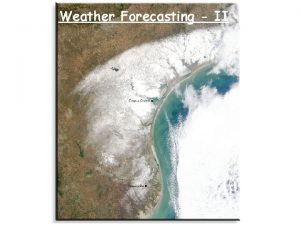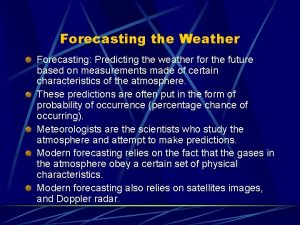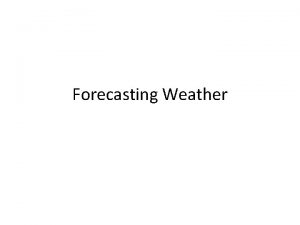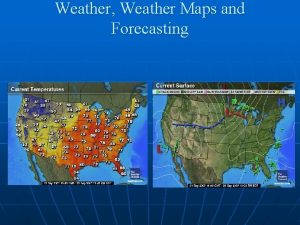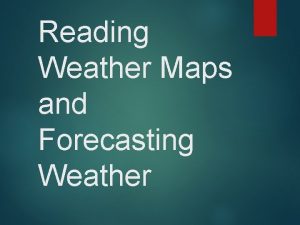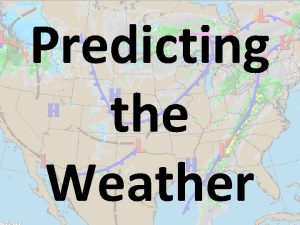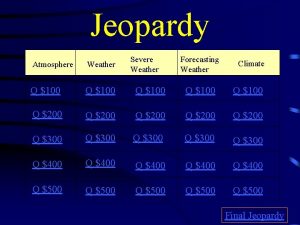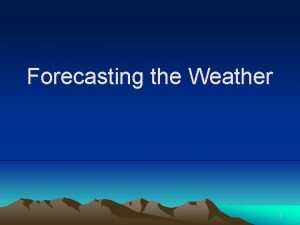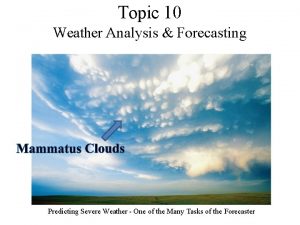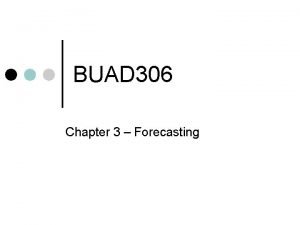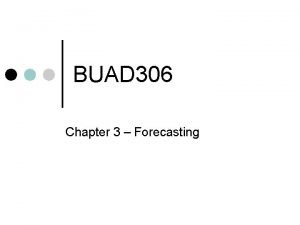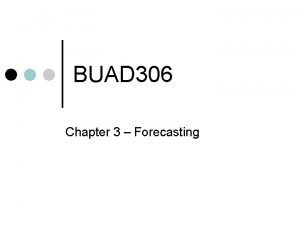Chapter 13 Weather Forecasting and Analysis Weather forecasting


































- Slides: 34

Chapter 13 Weather Forecasting and Analysis

Weather forecasting by the U. S. government began in the 1870 s when Congress established a National Weather Service under the authority of the Army Signal Corps. The National Oceanic and Atmospheric Administration (NOAA) was established in 1970 to include a number of environmental agencies, including the National Weather Service.

The Meteorological Service of Canada (MSC), located in Downsview, Ontario, assumes all forecasting duties for that country and provides local and regional information to its 14 regional weather centers.

Forecasts based on long-term information in the absence of any data about current weather are called climatological forecasts. The reliability of a climatological forecast depends on year-to-year variability in weather conditions for the forecast day.

A persistence forecast relies completely on current conditions with no reference to climatology. This simple procedure might work for a little while but will eventually fail to catch changes in weather.

The analog approach tries to recognize similarities between current conditions and similar well-studied patterns from before, assuming that what happened sometime in the past provides a clue about the future.

Numerical weather forecasting is based on computer programs that attempt to mimic the actual behavior of the atmosphere. The numerical models typically used in weather forecasting are very large and can only be run on the most powerful computers, so-called supercomputers.

Quantitative forecasts specify the “amount” of the forecast variable. For example, forecasts of the expected high or low temperature are quantitative because a value for the forecast variable is provided.

Qualitative forecasts provide only a categorical value for the predicted variable. For example, in a forecast of rain, the predicted variable is assigned to a particular class or category.

In a probability forecast, the chance of some event is stated. The most common example is the probability-of-precipitation forecast (Po. P forecast).

Forecast quality refers to the agreement between forecasts and observations. Forecast value refers to the utility of a forecast and necessarily depends on the application of a forecast to a particular problem or decision.

The quality of a forecast concerns forecast accuracy. That is, on average, how close is the forecast value to the true value?

Forecast bias concerns systematic over- or under-prediction. A biased forecast method is one whose average forecast is above or below the true average.

The mean absolute error (MAE), ignores the sign (positive or negative) of the errors. That is, over- and under-predictions are treated the same.

Forecast skill is defined as the improvement a method provides over what can be obtained using climatology, persistence, or some other “no-skill” standard.

Hydrogen-filled balloons carry weather instrument packages called radiosondes. Radiosondes tracked by radar are called rawinsondes.

The general procedure for all numerical models includes the following three phases: The analysis phase, in which observations are used to supply values corresponding to the starting state of the atmosphere for all the variables carried in the model.

The prediction phase begins with values delivered by the analysis phase using governing equations to obtain new values a few minutes into the future. The process is then repeated, using the output from the first step as input for the next set of calculations.

In the post-processing phase, conditions forecast by the model at regular intervals are represented in grid form for mapping and other display purposes.

Ensemble forecasting involves a number of different model runs performed for the same forecast period starting with slightly different initial values.

If two model runs are made with slightly different initial values, the results might be very different after a week or so. This behavior is now known to be typical of many natural and human systems, and is referred to as chaos.

Long-range forecasts include climatology, statistics, numerical models, and subjective judgment to produce forecasts for periods ranging from a week to the limits of technical feasibility.

Surface maps of prevailing conditions present a general depiction of sea level pressure distribution and the location of frontal boundaries.

Station models offer detailed knowledge of the conditions at a particular location with over a dozen weather elements represented on each station model.

An 850 mb map.

A 500 mb map.

A 300 mb map with isotachs (lines of equal wind speed).

Visible images view the atmosphere by registering the intensity of reflected shortwave radiation and are available only during the daytime.

Infrared images are based on measurements of longwave radiation emitted (not reflected) from below.

Water vapor image obtained from GOES 8 satellite.

Radar images observe the internal cloud conditions by measuring the amount of radiation backscattered by precipitation (both liquid and solid).

Vertical profiles of temperature and dew point observed by radiosondes are plotted on thermodynamic diagrams (pseudo-adiabatic charts). On the Stuve chart, air temperature is scaled along the horizontal axis and pressure is on a nearly logarithmic vertical axis. The straight, solid lines are dry adiabats and the dashed, slightly curved lines are wet adiabats, showing temperature changes in a rising saturated parcel.

The lifted index combines the average humidity in the lowest kilometer of the atmosphere, the predicted maximum temperature for the day, and the temperature at the 500 mb level into a single number. The K-index uses values of temperature and dew point at the surface and the 850, 700, and 500 mb levels.

The next chapter examines human effects: air pollution and heat islands.
 What does a wind vane measure
What does a wind vane measure Forecasting weather map worksheet #1
Forecasting weather map worksheet #1 How are computers used in weather forecasting
How are computers used in weather forecasting Persistence method of weather forecasting
Persistence method of weather forecasting Statistical forecasting techniques
Statistical forecasting techniques Introduction to weather forecasting
Introduction to weather forecasting Thunder is the sound of brainpop
Thunder is the sound of brainpop Financial analysis planning and forecasting
Financial analysis planning and forecasting Regression analysis in business forecasting
Regression analysis in business forecasting Weather station model examples
Weather station model examples Whether the weather be cold
Whether the weather be cold Weather and clothes
Weather and clothes Its windy gif
Its windy gif Whether the weather is fine or whether the weather is not
Whether the weather is fine or whether the weather is not Heavy weather by weather report
Heavy weather by weather report Capital weather gang weather wall
Capital weather gang weather wall Operations management chapter 4 forecasting solutions
Operations management chapter 4 forecasting solutions Ft=ft-1+a(at-1-ft-1)
Ft=ft-1+a(at-1-ft-1) Forecasting in operations management
Forecasting in operations management Chapter 15 financial forecasting for strategic growth
Chapter 15 financial forecasting for strategic growth Compare and contrast weather
Compare and contrast weather Compare and contrast analog and digital forecasting
Compare and contrast analog and digital forecasting Chapter 20 weather patterns and severe storms
Chapter 20 weather patterns and severe storms World geography chapter 3 weather and climate
World geography chapter 3 weather and climate Chapter 3 section 1 seasons and weather
Chapter 3 section 1 seasons and weather Chapter 20 weather patterns and severe storms
Chapter 20 weather patterns and severe storms Weather map lab
Weather map lab Weather surface analysis
Weather surface analysis Forecasting and management of technology
Forecasting and management of technology Demand forecasting in managerial economics
Demand forecasting in managerial economics Demand estimation and forecasting
Demand estimation and forecasting Collaborative planning and forecasting
Collaborative planning and forecasting Barometric methods are used to forecast
Barometric methods are used to forecast Forecasting and demand measurement in marketing
Forecasting and demand measurement in marketing Current market demand
Current market demand
